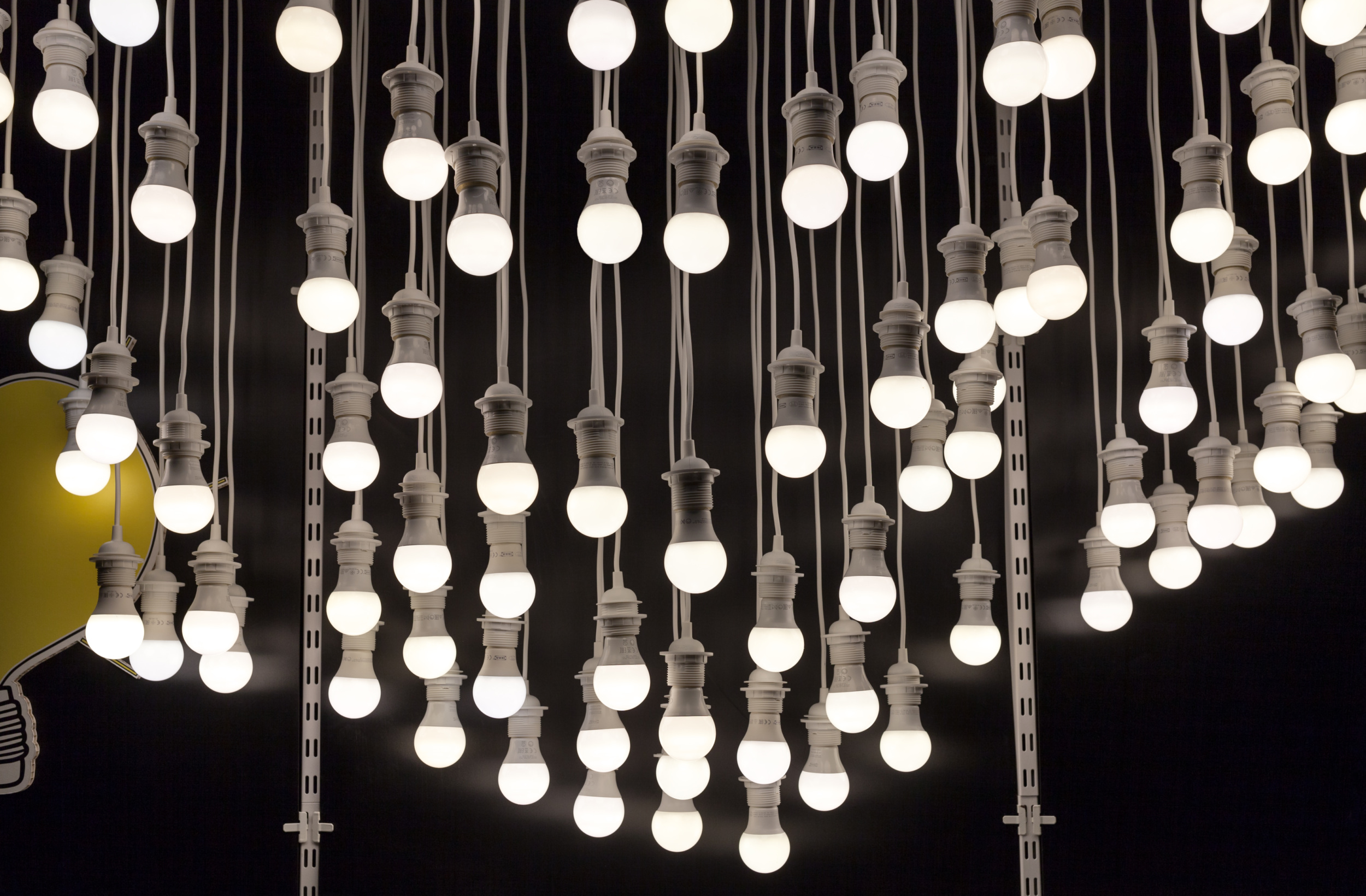
Lighting a Billion: The UJALA Program’s Transformational Impact in India
Summary: In 2015, India launched the world’s largest subsidy-free lighting replacement initiative called the Unnat Jyoti by Affordable LEDs for All (UJALA) program. This pioneering public-private partnership for efficient lighting promoted the transition to energy-efficient light-emitting diode (LED) bulb from traditional incandescent and compact fluorescent lamp (CFL) bulbs. As of 2022, the program was saving households INR 191 billion on their electricity bills per year1 and curbed India’s annual CO2 emissions by 37 million tonnes of CO2.2 India’s successful lighting transformation exemplifies effective government-private sector synergy in promoting environmentally friendly and cost-effective appliance alternatives.
Challenge: Lighting represented a large share of total household electricity demand. In 2015, lighting accounted for roughly 26% of India’s residential electricity consumption.3 LEDs offered an efficient lighting solution to help reduce residential energy consumption. They are 75% more efficient and have a lifespan of 25 times longer than incandescent lighting. However, high upfront costs prevented them from being the dominant technology in the residential market. Of the 990 million lighting points in Indian households in 2011, CFLs made up 45% of the market, while tube lights and incandescent bulbs made up 40% and 14% of the market, respectively.4 Energy-efficient LEDs made up a mere 0.3% of the market in 2011.5
In response, the Indian government launched the UJALA scheme in 2015 to enhance LED affordability. The UJALA initiative aimed to decrease national energy consumption by enhancing the market acceptance of energy-efficient LED bulbs. It was established as a joint project between the Government of India’s Public Sector Undertakings, the Union Ministry of Power’s Energy Efficiency Services Limited (EESL) and India’s power distribution companies (DISCOMs).
Solution: Using a demand aggregation model to lower upfront costs, LED bulbs are distributed to households at subsidized rates, making them affordable and accessible.
UJALA aimed to replace 770 million conventional, energy-inefficient lighting solutions with modern, energy-efficient, and longer lasting LEDs.6
To initiate the scheme, from 2015 EESL invited manufacturers to bid for a large-scale LED lamp procurement, covering all initial expenses. EESL also engaged with state governments and DISCOM utilities to establish a distribution network.
Leveraging the government’s capacity to make bulk purchases and negotiate competitive prices, EESL acquires bulbs from manufacturers at rates lower than that in the local market. These bulbs are then distributed among domestic consumers who register to participate in the program. The distribution is done through various channels, including electricity distribution companies, non-governmental organizations, and government agencies. These stakeholders play a pivotal role in program implementation by identifying potential consumers and facilitating the distribution process. The program incorporates stringent quality control measures, along with comprehensive measuring, reporting, and verification procedures, fostering trust in the initiative and enhancing its effectiveness and impact.
Impact
Energy Savings and Cost Reductions
- As of January 2022, the program had distributed over 360 million LED bulbs, saving over 47 billion kWh and avoiding 37 million tons of CO2 emissions annually.7
- Between 2014 and 2017, the program decreased LED bulb retail costs between 76-80%, from INR 300-350 per bulb in 2014 to INR 70-80 per bulb in 2017.8
- Over that same three-year period, procurement prices were reduced by almost 90%, from INR 310 in 2014 to 38 INR in 2017.9
Improved Household Finances
- Saved households INR 191 billion on their electricity bills per year.10
Quality Assurance and Consumer Protection
- Safeguarded customers from substandard products. EESL’s specifications ensured high-quality LED bulbs with a ≤0.3% failure rate and a mandatory three-year warranty.
National and International Influence
- Inspired similar bulk procurement programs nationally, like the Super-Efficient Air Conditioning Program (ESEAP) launched in 2019.11
- Helped create a roadmap for similar programs internationally, such as Malaysia’s Efficient Lighting Initiative (ELI) launched in 2018.12
Lessons Learned
These key lessons learned from UJALA were essential to its success and can be applied to similar programs:
- Bulk procurement: The UJALA program’s success was largely due to its bulk procurement strategy, which allowed for the purchase of large quantities of LED bulbs at a lower cost. To replicate and maintain a subsidy free model, it is crucial to implement market-based mechanisms. EESL achieved this by aggregating demand and purchasing high-quality LED bulbs in bulk at an affordable price, through its own balance sheet.
- Public-private partnership: Implemented through a public-private partnership, the program’s open procurement tenders involved multiple bidders, broadening manufacturing sector acceptance. This approach developed local manufacturing capacity and reduced risks. UJALA’s self-sustained model, a public good independent of government funding, appealed to sub-national governments for deployment.
- Incentives to mitigate consumer risk appetite: In the early stages, EESL acknowledged that customers might hesitate to pay a relatively high price for a technology they are unfamiliar with. To tackle this issue, an on-bill financing program was introduced as part of the UJALA program. The program allows consumers to pay for their LED bulbs in installments that are added to their monthly electricity bills. This approach made it easier for consumers to switch to energy-efficient lighting without bearing the full cost upfront.
- Collaboration: Effective stakeholder engagement is essential for the success of large-scale policy programs. Given the vast geographical expanse and diversity of India, EESL accomplished this by forging partnerships with relevant stakeholders, such as local authorities, municipalities and DISCOMs, and establishing a network of regional offices to extend its outreach.
- Consumer awareness: The UJALA program was successful in part due to its focus on consumer awareness and education. The program utilized various marketing and outreach strategies to promote the benefits of energy-efficient lighting and encourage consumers to switch to LED bulbs. The National UJALA Dashboard, which tracks and updates LED distribution in real-time, sets a significant precedent for enhancing the transparency of national programs and offering up-to-date information for effective monitoring, reporting, and verification. Similar initiatives can replicate this approach to increase the adoption of energy-efficient products and behaviors.13
- Strong enabling environment: The Indian government established policies and incentives, such as mandating LED bulb use in government buildings, to foster program success. This enabled EESL to secure buy-in from state governments and DISCOMs. Additionally, the government offered financial incentives to boost LED manufacturers’ production capacity. These measures helped to ensure that LED bulbs were widely available and reduced costs even further.14
0. EESL. “Innovating Energy.” EESL, 2022. https://eeslindia.org/wp-content/uploads/2022/03/Newsletter-Feb-2022_Main.pdf.
1. “Salient Features of UJALA and SLNP Programmes,” Ministry of Power (Ministry of Power, March 22, 2022), India Ministry of Power, https://pib.gov.in/PressReleasePage.aspx?PRID=1808264.
2. Ali, Sahil. “The Future of Indian Electricity Demand.” Washington, DC: Brookings Institution, 2018. https://www.brookings.edu/wp-content/uploads/2018/10/The-future-of-Indian-electricity-demand.pdf.
3. PwC. “Roadmap for Demand Aggregation of LED Lighting: Final Report.” PricewaterhouseCoopers (PwC), 2013. https://shaktifoundation.in/wp-content/uploads/2014/02/LED-Demand-Aggregation-Roadmap.pdf.
4. PwC. “Roadmap for Demand Aggregation of LED Lighting: Final Report.” PricewaterhouseCoopers (PwC), 2013. https://shaktifoundation.in/wp-content/uploads/2014/02/LED-Demand-Aggregation-Roadmap.pdf.
5. Energy Efficiency Services Limited, “India’s UJALA Story,” Case Study (Energy Efficiency Services Limited, 2020).
6. “Salient Features of UJALA and SLNP Programmes,” Ministry of Power (Ministry of Power, March 22, 2022), India Ministry of Power, https://pib.gov.in/PressReleasePage.aspx?PRID=1808264.
7. “Salient Features of UJALA and SLNP Programmes,” Ministry of Power (Ministry of Power, March 22, 2022), India Ministry of Power, https://pib.gov.in/PressReleasePage.aspx?PRID=1808264.
8. “UJALA Completes 7 Years of Energy-Efficient and Affordable LED Distribution,” Press Information Bureau (Press Information Bureau, January 5, 2022), Government of India, https://pib.gov.in/PressReleasePage.aspx?PRID=1808264.
9. EESL. “Innovating Energy.” EESL, 2022. https://eeslindia.org/wp-content/uploads/2022/03/Newsletter-Feb-2022_Main.pdf.
10. Press Information Bureau, “Super-Efficient Air Conditioning Programme Launched by EESL” (Government of India, Ministry of Power, 2019), https://pib.gov.in/Pressreleaseshare.aspx?PRID=1566015.
11. Anisha Dutta, “EESL to Sign MoU with Malaysian Counterpart to Replicate UJALA Scheme in Malaysia,” Economic Times EnergyWorld, August 18, 2017, http://energy.economictimes.indiatimes.com/news/power/eesl-to-sign-mou-with-malaysian-counterpart-to-replicate-ujala-scheme-in-malaysia/60119704.
12. GIZ and UNDP, “Market-Making for Low-Carbon Energy Technologies: The Ujala Scheme in India” (Partnership on Transparency in the Paris Agreement, 2018), https://api.knack.com/V1/Applications/5b23f04fd240aa37e01fa362/Download/Asset/5c94a552be4c1909acfe389b/190318_gpd_parisabkommen_india_rz.pdf.
13. Business Standard. (2019, September 9). How Ujala is shaping a brighter future for India. Business Standard. https://www.business-standard.com/article/economy-policy/how-ujala-is-shaping-a-brighter-future-for-india-119090900044_1.html
